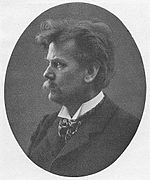Adolf Furtwängler facts for kids
Quick facts for kids
Adolf Furtwängler
|
|
|---|---|

Adolf Furtwängler
|
|
| Born | 30 June 1853 Freiburg im Breisgau, Germany
|
| Died | 10 October 1907 (aged 54) Athens, Greece
|
| Scientific career | |
| Fields | Archaeology |
Adolf Furtwängler (born June 30, 1853 – died October 10, 1907) was a famous German archaeologist. He was also a teacher, an art historian, and a museum director. You might know his son, Wilhelm Furtwängler, who was a famous conductor, or his grandson, Andreas Furtwängler, who is also an archaeologist.
Contents
Adolf's Early Life and Education
Adolf Furtwängler was born in Freiburg im Breisgau, Germany. His father was a teacher and studied ancient cultures. Adolf went to school in Freiburg, then studied in Leipzig and Munich. In Munich, he learned from Heinrich Brunn, a well-known art expert. Adolf really improved on Brunn's way of comparing different artworks to understand them better.
Adolf's Archaeology Career
After studying at the University of Leipzig, Adolf Furtwängler finished his studies in Freiburg in 1874. He wrote about "Eros in Vase Painting" for his final paper. From 1876 to 1878, he received a scholarship to study in Italy and Greece.
Excavations and Discoveries
In 1878, Furtwängler joined Ernst Curtius's team excavating at Olympia. This was a very important archaeological site.
In 1879, he published a book called Mykenische Thongefäβe with Georg Loeschcke. This book was about the Mycenaean pottery found on the island of Aegina. It was the first complete collection of pottery finds in archaeology. This study helped archaeologists tell the difference between Mycenaean and Geometric styles of pottery. It also showed how pottery pieces, called sherds, could help date archaeological sites. By looking at similar vases found in different layers of earth, Furtwängler could use these sherds to figure out how old a site was.
Working in Berlin
Because of his important work, Furtwängler received two jobs in 1880. He became an assistant director at the Royal Museums of Berlin. He also became a teacher at the University of Berlin. Later, he felt that he spent his best years working at the museum.
His book about the Saburov collection (1883–87) showed how well he understood classical terracottas. These are ancient artworks made from baked clay.

In 1885, he married Adelheid Wendt. That same year, his catalog of Greek pottery from the Antikensammlung Berlin was published. It was called Beschreibung der Vasensammlung im Antiquarium.
Masterpieces of Greek Sculpture
His book on Greek sculpture, Meisterwerke der griechischen Plastik (1893), made him famous to more people. An English version, Masterpieces of Greek Sculpture, came out in 1895. Furtwängler was very skilled at identifying the original Greek sculptors. He did this by studying Roman copies of their works. Many of his ideas about who made which sculpture are still believed today.
He also recreated the Lemnian Athena statue by Phidias in 1891. These recreations were very famous, and you can see them in the Dresden Albertinum museum.
Moving to Munich
In 1894, Furtwängler left Berlin. He became a professor of classical archaeology in Munich, taking over from his old teacher, Heinrich von Brunn. He also became the Director of the Munich Glyptothek, a museum of ancient sculptures.
In 1896, in his book Beschreibung der geschnittenen Steine im Antiquarium, Furtwängler decided not to include engraved gems linked to magic. He thought their artistic value was not important. Because of this, he believed these types of engraved stones should not be shown in the Egyptology collection.
Furtwängler also wrote a study on Greek engraved gems and their writings, called Die Antiken Gemmen (1900). With Karl W. Reichhold, he started a collection of Greek vases called Griechische Vasenmalerei in 1904.
Final Work and Legacy
Furtwängler returned to fieldwork and restarted excavations at the temple of Aphaia in Aegina, Greece. He published a book about this site in 1906. Sadly, the next year, he caught dysentery at the site and passed away on October 10, 1907. He was buried in Athens at the First Cemetery of Athens.
Adolf Furtwängler's Impact
Adolf Furtwängler wrote many books and articles. He had amazing knowledge and memory. His work was very important in archaeology and helped raise its importance around the world.
Some of his most important books were about bronzes found at Olympia, ancient gems, and Greek vases. His book Meisterwerke der griechischen Plastik (Masterpieces of Greek Sculpture) was especially valuable.
Many of Furtwängler's students became important art historians and archaeologists. His research also had a wide influence on others in the field.
See also
 In Spanish: Adolf Furtwängler para niños
In Spanish: Adolf Furtwängler para niños

